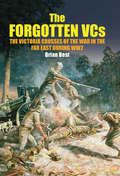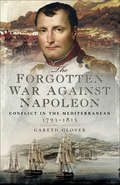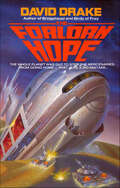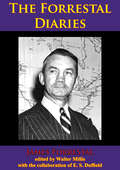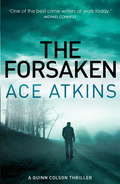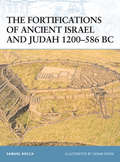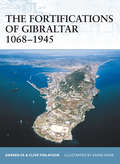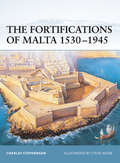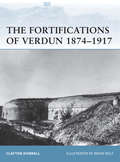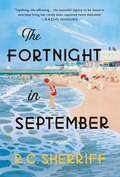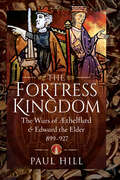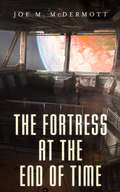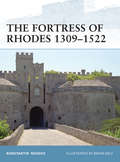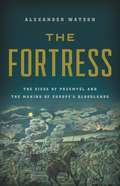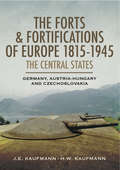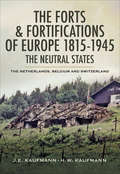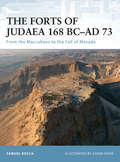- Table View
- List View
The Forgotten Soldier
by Guy SajerAn international bestseller, this is a German soldier's first-hand account of life on Russian front during the second half of the Second World War.When Guy Sajer joins the infantry full of ideals in the summer of 1942, the German army is enjoying unparalleled success in Russia. However, he quickly finds that for the foot soldier the glory of military success hides a much harsher reality of hunger, fatigue and constant deprivation. Posted to the crack Grosse Deutschland division, with its sadistic instructors who shoot down those who fail to make the grade, he enters a violent and remorseless world where all youthful hope is gradually ground down, and all that matters is the brute will to survive. As the biting cold of the Russian winter sets in, and the tide begins to turn against the Germans, life becomes an endless round of pounding artillery attacks and vicious combat against a relentless and merciless Red Army. A book of stunning force, this is an unforgettable reminder of the horrors of war.
The Forgotten Soldier: A Pike Logan Thriller
by Brad TaylorIn New York Times bestselling author Brad Taylor's latest heart-stopping thriller, Pike Logan returns with his most dangerous and personal threat yet: a Taskforce Operator gone rogue. For years, the extralegal counterterrorist unit known as the Taskforce has worked in the shadows, anticipating and preventing attacks around the globe. Created to deal with a terrorist threat that shuns the civilized rule of law, it abandoned the same, operating outside of the US Constitution. Though wildly successful, it was rooted in a fear that the cure could be worse than the disease. And now that fear has come home. A Special Forces soldier is killed on an operation in Afghanistan, and complicit in the attack is a government official of an allied nation. While the US administration wants to forget the casualty, one Taskforce member will not. When he sets out to avenge his brother's death, his actions threaten to not only expose the Taskforce's activities but also destroy a web of alliances against a greater evil. Pike Logan understands the desire but also the danger. Brought in to eliminate the risk, he's now forced to choose between his friend and the administration he's sworn to protect, while unbeknownst to either of them, the soldier's death is only the beginning. . . .From the Hardcover edition.
The Forgotten VCs: The Victoria Crosses of the War in the Far East During WW2
by Brian BestFought amid the most challenging terrain of any theater during the Second World War, the campaign in the Far East saw heroic actions against the unyielding Japanese that resulted in the awarding of more than forty Victoria Crosses greater than a fifth of all the VCs of the war.Such actions include that of Major Frank Blaker, whose battalion of the Gurkha Rifles was held up by Japanese machine-guns on 9 July 1944. After climbing for five hours up a 2,100-foot hill, Blaker crawled on his hands and knees through dense jungle alone until he was close enough to stand up and charge the strong enemy position. Though mortally wounded, he urged his men to follow and the hilltop was taken.During the famous Chindit operations, Lieutenant George Cairns was with the South Staffordshire Regiment as it attacked a Japanese position on top of Pagoda Hill. The Chindits reached the summit and, charging into the Japanese, a vicious hand-to-hand battle ensued. In the fighting a Japanese officer hacked off Cairns left arm but, astonishingly, the young Londoner then killed the enemy officer, picked up the sword with his right hand and carried on fighting. He died the next day.The Gurkhas are renowned for their courage and it is unsurprising that many of the Fourteenth Armys VCs were won by these tough Nepalese soldiers. Rifleman Bhanbhagta Gurung found his battalion of the 2nd Gurkha Rifles pinned down by an enemy sniper. So he stood up in the open and killed the Japanese soldier. As his battalion advanced again, it once more came under enemy fire. Bhanbhagta Gurung charged the enemy positions, taking five Japanese foxholes, one by one in the face of almost pointblank fire.The wide-ranging nature of the conflict in the Far East saw awards being granted for actions not just in Burma but also in India, Hong Kong, Singapore, Malaya, Borneo, New Guinea and even off the coast of Japan itself. The recipients came from across the Commonwealth, including Australia, Canada, Fiji, Great Britain, India and Nepal.These VC actions are told in great detail in The Forgotten VCs, the first book to examine in depth the Victoria Crosses of the war in the Far East. Brian Best brings to life the daring deeds of a group of courageous men in the most inhospitable of battlefield conditions, filling a glaring gap in the historiography of Britains most prestigious award for valor.
The Forgotten War (Star Trek: The Next Generation #57)
by William R. ForstchenThe legendary Starfleet Captain Lucien Murat, a contemporary of Christopher Pike, disappeared during a battle with the alien Tarn. Now, generations later, Captain Picard is conducting delicate diplomatic negotiations with the Tarn when the Starship Enterprise discovers the descendants of Murat and his crew stranded on a desolate planet, still fighting a war that ended decades ago. The human castaways face destruction, but more than these precious lives are at stake. Unless Picard can find a solution, a lost hero's legacy may ignite a new era of interstellar war!
The Forgotten War Against Napoleon: Conflict in the Mediterranean, 1793–1815
by Gareth Glover&“A comprehensive look at the Mediterranean and adjacent territories, a largely &‘forgotten&’ theatre of the very long Anglo-French war.&” —New York Military Affairs Symposium The campaigns fought against Napoleon in the Iberian Peninsula, in France, Germany, Italy and Russia and across the rest of Europe have been described and analyzed in exhaustive detail, yet the history of the fighting in the Mediterranean has rarely been studied as a separate theater of the conflict. Gareth Glover sets this right with a compelling account of the struggle on land and at sea for control of a region that was critical for the outcome of the Napoleonic Wars. The story of this twenty-year conflict is illustrated with numerous quotes from a large number of primary sources, many of which are published here for the first time. &“This is a well researched and well written account of the most complex long term military commitment for Britain during the Napoleonic Wars, involving multiple theatres spread out over a large area, cooperation between the Navy and the Army, an ever changing cast of senior officers, opponents and allies, often made more complex by the time taken to get messages from London to the officers in the field.&” —History of War
The Forlorn Hope
by David DrakeA band of mercenaries must fight their way across a hostile planet after they’re sold out to the enemy in this classic military science fiction odyssey.They had fought long and hard, and damn near won in spite of everything. But now the men who hired them are going to sell them to the enemy . . . and so begins a novel of adventure in which a band of Star Mercenaries is driven across the face of a planet by enemies bent on their destruction. With only the guns in their hands, this tiny band must battle ships, artillery, treachery, and the most powerful tank in the universe . . .Praise for The Forlorn Hope“Vigorous and compelling. . . . A book that any Hammer’s Slammers fan will enjoy. . . . A page-turner, fast-paced and hard to put down.” —Reactor
The Formation of Japan-ROK Security Relations: Meeting the Evolving Cold War Challenge
by Kyungwon ChoiThis open access book argues that Japan-ROK security relations were formed in the process of adjusting the threat perception gap and policy conflict between the two countries. Conventional analyses using a “cooperation or conflict” dichotomy are too limited to capture the complex coordination of interests that security relations entail. In comparison, this book focuses on how, as they interacted on security concerns, Japan and the ROK had different threat perceptions and foreign policy orientations that resulted in friction over the means and methods of responses and shines a light on the changes apparent in the adjustment process. The author aims to elucidate how Japan and the ROK approached security cooperation over the period from the late 1960s to the mid-1970s. As Japan and the ROK looked to reconcile the differing political positions involved in these security and détente requirements, they explored and began to show new developments in bilateral security cooperation. This book provides a new perspective on Japan-ROK security relations and through this lens a broader view of international relations in East Asia. It also proves useful in understanding bilateral cooperation in the security field following the normalization of diplomatic relations between the two countries.
The Forrestal Diaries
by Walter Millis James ForrestalJames Vincent Forrestal (1892-1949) was the last Cabinet-level United States Secretary of the Navy and the first United States Secretary of Defense. These fascinating diaries begin in 1944 shortly after James Forrestal became Secretary of the Navy, and end with his resignation in March 1949 as America's first Secretary of Defense. Blunt and forceful, Forrestal reveals the American strategy that he helped shape with verve. Expertly edited by seasoned historian Walter Millis, the American high command as is seen in a rare light as the Second World War finishes and the Cold War begins and gathers pace.
The Forsaken (Quinn Colson #4)
by Ace AtkinsThirty-six years ago, a nameless black man wandered into Jericho, Mississippi, with nothing but the clothes on his back and a pair of paratrooper boots. Less than two days later, he was accused of rape and murder, hunted down by a self-appointed posse, and lynched.Now evidence has surfaced of his innocence, and county sheriff Quinn Colson sets out not only to identify the stranger's remains, but to charge those responsible for the lynching. As he starts to uncover old lies and dirty secrets, though, he runs up against fierce opposition from those with the most to lose - and they can play dirty themselves.Soon Colson will find himself accused of terrible crimes, and the worst part is, the accusations just might stick. As the two investigations come to a head, it is anybody's guess who will prevail - or even come out of it alive.
The Fort
by Bernard CornwellWhile the major fighting of the war moves to the south in the summer of 1779, a British force of fewer than a thousand Scottish infantry, backed by three sloops-of-war, sails to the desolate and fog-bound coast of New England. Establishing a garrison and naval base at Penobscot Bay, in the eastern province of Massachusetts that would become Maine, the Scots--the only British troops between Canada and New York--harry rebel privateers and give shelter to American loyalists. In response, Massachusetts sends a fleet of more than forty vessels and some one thousand infantrymen to "captivate, kill or destroy" the foreign invaders. Second in command is Peleg Wadsworth, a veteran of the battles at Lexington and Long Island, once aide to General Washington, and a man who sees clearly what must be done to expel the invaders. But ineptitude and irresolution lead to a mortifying defeat--and have stunning repercussions for two men on opposite sides: an untested eighteen-year-old Scottish lieutenant named John Moore, who will begin an illustrious military career; and a Boston silversmith and patriot named Paul Revere, who will face court-martial for disobedience and cowardice.Grounded firmly in history, inimitably told in Cornwell's thrilling narrative style, The Fort is the extraordinary novel of this fascinating clash between a superpower and a nation in the making.
The Fort Pillow Massacre: North, South, and the Status of African Americans in the Civil War Era (Critical Moments in American History)
by Bruce TapOn April 12, 1864, a small Union force occupying Fort Pillow, Tennessee, a fortress located on the Mississippi River just north of Memphis, was overwhelmed by a larger Confederate force under the command of Nathan Bedford Forrest. While the battle was insignificant from a strategic standpoint, the indiscriminate massacre of Union soldiers, particularly African-American soldiers, made the Fort Pillow Massacre one of the most gruesome slaughters of the American Civil War, rivaling other instances of Civil War brutality. The Fort Pillow Massacre outlines the events of the massacre while placing them within the racial and social context of the Civil War. Bruce Tap combines a succinct history with a selection of primary documents, including government reports, eyewitness testimony, and newspaper articles, to introduce the topic to undergraduates.
The Fortifications of Ancient Israel and Judah 1200-586 BC
by Samuel RoccaThis book provides a detailed study of the fortifications of the founders of Ancient Israel from the time of their first settlement in the Middle East, through the periods of the united and divided kingdoms, until the sack of Jersualem in 586 BC. It begins in the period of Israelite settlement in the First Iron Age period (1200-1000 BC). The extensive fortifications created by the famous kings Saul, David and Solomon are covered, including Gibeah, Jerusalem, Megiddo, Hazor and Gezer, which are described in the Bible. The period of the Divided Monarchy saw the creation of two separate political entities: the kingdoms of Israel and Judah. The enemies the two kingdoms faced in this period included Moab, Edom, the Arameans as well as the mighty empires of Assyria, Babylonia and Egypt.
The Fortifications of Gibraltar 1068-1945
by Adam Hook Darren Fa Clive FinlaysonGibraltar is not only an archetypal fortress, preserving in its dominating topography and walls, bastions and emplacements a rich testament to extended periods of human conflict, but it is also a unique record of the evolution of the sciences of fortification and associated defensive structures over a period of more than six centuries. Gibraltar has a complex and varied military history, lying as it does at the gateway to the Mediterranean and the meeting points of the continents of Europe and Africa. Its history, always shaped by its unique combination of strategic position and topography, begins in ancient times with successive occupations by Phoenicians, Carthaginians and Romans. It then passed through Arab, Castilian and Spanish hands, and has been a British possession since 1704. The Rock served as a base for Nelson's fleet in the Napoleonic Wars and, in World War II, for the Royal Navy's Task Force 'H' and as as a vital stopping place for supply convoys plying to and from the East through the Suez Canal and supporting the Allied effort in the Mediterranean Theater. An unprecedented amount of tunnelling took place on Gibraltar, making it a veritable warren that housed aircraft hangars, ammunition stores, hospitals and even a secret chamber (the Stay-Behind Cave) that was to be manned as an observation post in the event of a hostile takeover.
The Fortifications of Malta 1530-1945
by Steve Noon Charles StephensonThe Island of Malta occupies a pivotal position in the Mediterranean, forming an outpost between North Africa and the soft underbelly of Europe. Such has been its strategic importance throughout the years that it has become one of the most fortified places in the world. Following the successful defence of the island during the Great Siege of 1565, the Knights Hospitaller built new walls and fortifications. These defences failed when Napoleon occupied Malta in 1798, and the island was retaken by the British in 1800. From this point onwards, Malta's defences were modernised throughout the 19th century and the island's final test came during World War II. This book examines all these different styles of fortification from the 16th to the 20th century.
The Fortifications of Verdun 1874-1917
by Brian Delf Clayton DonnellThe ring of fortifications protecting the city of Verdun on the Meuse River would become critical in the infamous battle of World War I. This book examines these fortifications, including the famous forts of Douaumont and Vaux that saw some of the fiercest fighting during the battle.
The Fortnight in September: A Novel
by R.C. SherriffThis charming, timeless classic about a family of five setting out on their annual seaside vacation is &“the most uplifting, life-affirming novel I can think of...the beautiful dignity to be found in everyday living has rarely been captured more delicately&” (Kazuo Ishiguro).Meet the Stevens family, as they prepare to embark on their yearly holiday to the coast of England. Mr. and Mrs. Stevens first made the trip to Bognor Regis on their honeymoon, and the tradition has continued ever since. They stay in the same guest house and follow the same carefully honed schedule—now accompanied by their three children, twenty-year-old Mary, seventeen-year-old Dick, and little brother Ernie. Arriving in Bognor they head to Seaview, the guesthouse where they stay every year. It&’s a bit shabbier than it once was—the landlord has died and his wife is struggling as the number of guests dwindles every year. But the family finds bliss in booking a slightly bigger cabana, with a balcony, and in their rediscovery of the familiar places they visit every year. Mr. Stevens goes on his annual walk across the downs, reflecting on his life, his worries and disappointments, and returns refreshed. Mrs. Stevens treasures an hour spent sitting alone with her medicinal glass of port. Mary has her first small taste of romance. And Dick pulls himself out of the malaise he&’s sunk into since graduation, resolving to work towards a new career. The Stevenses savor every moment of their holiday, aware that things may not be the same next year. Delightfully nostalgic and soothing, The Fortnight in September is an extraordinary novel about ordinary people enjoying life&’s simple pleasures.
The Fortress Kingdom: The Wars of Aethelflaed & Edward the Elder, 899–927
by Paul HillIn this the second part of his four-volume military and political history of the Anglo-Saxon kingdom, Paul Hill follows the careers of Æthelflæd, Alfred the Great’s eldest daughter, and Edward the Elder, Alfred’s eldest son, as they campaigned to expand their rule after Alfred’s death. They faced, as Alfred had done, the full force of Danish hostility during the early years of the tenth century, a period of unrelenting turbulence and open warfare. But through their military strength, in particular their strategy of fortress building, they retained their hold on the kingdom and conquered lands which had been under Danish lords for generations. Æthelflæd’s forces captured Derby and Leicester by both force and diplomacy. Edward’s power was always immense. How each of them used forts (burhs) to hold territory, is explored. Fortifications across central England became key. These included Bridgnorth, Tamworth, Stafford, Warwick, Chirbury and Runcorn (Æthelflæd) and also Hertford, Witham, Buckingham, Bedford and Maldon (Edward), to name a few. Paul Hill’s absorbing narrative incorporates the latest theories and evidence for the military organization and capabilities of the Anglo-Saxons and their Danish adversaries. His book gives the reader a detailed and dramatic insight into a very sophisticated Anglo-Saxon kingdom.
The Fortress at the End of Time
by Joe M. McdermottCaptain Ronaldo Aldo has committed an unforgivable crime. He will ask for forgiveness all the same: from you, from God, even from himself.Connected by ansible, humanity has spread across galaxies and fought a war against an enemy that remains a mystery. At the edge of human space sits the Citadel—a relic of the war and a listening station for the enemy's return. For a young Ensign Aldo, fresh from the academy and newly cloned across the ansible line, it's a prison from which he may never escape.Deplorable work conditions and deafening silence from the blackness of space have left morale on the station low and tensions high. Aldo's only hope of transcending his station, and cloning a piece of his soul somewhere new is both his triumph and his terrible crime.The Fortress at the End of Time is a new science fiction novel from Joe M. McDermott.At the Publisher's request, this title is being sold without Digital Rights Management Software (DRM) applied.
The Fortress in Orion (Dead Enders #1)
by Mike ResnickThe Democracy is at war with the alien Traanskei Coalition. War hero Colonel Nathan Pretorius has a record of success on dangerous behind-enemy-lines missions, missions that usually leave him in the hospital. Now he's recruited for a near-impossible assignment that may well leave him dead. At the cost of many lives, the Democracy has managed to clone and train General Michkag, one of the Traanskei's master strategists. Colonel Pretorius and a hand-picked team must kidnap the real Michkag if they can, assassinate him if they can't, but no matter which, put the clone in his place, where he will misdirect the enemy's forces and funnel vital information to the Democracy.Against the odds, Pretorius, along with Cyborg Felix Ortega, computer expert Toni Levi, convict and contortionist Sally "Snake" Kowalski, the near-human empath Marlowe, the alien Gzychurlyx, and Madam Methuselah - the Dead Enders - must infiltrate the Fortress in Orion, accomplish their mission, and escape with their lives.
The Fortress in the Age of Vauban and Frederick the Great 1660-1789 (Routledge Library Editions: Military and Naval History #8)
by Christopher DuffyThe later seventeenth and eighteenth centuries have been acclaimed as the classic period of artillery fortification. This was an era when fortresses and fortress systems shaped the calculations of strategists and statesmen, and often dictated the course of campaigns. The age was one of almost constant conflict and this book, originally published in 1985, explores the influence of the fortress in the dynastic wars of Bourbon, Habsburg and Hohenzollern, the contest for influence in the Baltic, the last crusades of the West against the Turks, and in the peculiar conditions of colonial campaigning and the War of the American Independence.
The Fortress of Rhodes 1309-1522
by Brian Delf Konstantin NossovFirst besieged in 305 BC, the island of Rhodes became part of the Roman Empire and was later fortified in the Byzantine style. Due to its strategic position in the Mediterranean, Rhodes was also attacked and besieged for over a century by Islamic forces. This title details the development of these fascinating fortifications, as well as the sieges that sought to reduce them.
The Fortress: The Siege of Przemysl and the Making of Europe's Bloodlands
by Alexander WatsonA prizewinning historian tells the dramatic story of the siege that changed the course of the First World WarIn September 1914, just a month into World War I, the Russian army laid siege to the fortress city of Przemysl, the Hapsburg Empire's most important bulwark against invasion. For six months, against storm and starvation, the ragtag garrison bitterly resisted, denying the Russians a quick victory. Only in March 1915 did the city fall, bringing occupation, persecution, and brutal ethnic cleansing.In The Fortress, historian Alexander Watson tells the story of the battle for Przemysl, showing how it marked the dawn of total war in Europe and how it laid the roots of the bloody century that followed. Vividly told, with close attention to the unfolding of combat in the forts and trenches and to the experiences of civilians trapped in the city, The Fortress offers an unprecedentedly intimate perspective on the eastern front's horror and human tragedy.
The Forts & Fortifications of Europe 1815-1945: Germany, Austria-Hungry and Czechoslovakia
by H. W. Kaufmann J. E. Kaufmann&“Extremely well written and presented and gives you every scrap of information you&’ll ever need on cupolas, embrasures and cloches.&”—War History Online After the Napoleonic Wars, the borders of Central Europe were redrawn and relative peace endured across the region, but the volatile politics of the late nineteenth century generated an atmosphere of fear and distrust, and it gave rise to a new era of fortress building, and this is the subject of this highly illustrated new study. The authors describe how defensive lines and structures on a massive scale were constructed along national frontiers to deter aggression. The Germans, Austro-Hungarians and Czechs all embarked on ambitious building programs. Artillery positions, barbed-wire networks, casemates, concrete bunkers, trench lines, observation posts all sprang up in a vain attempt to keep the peace and to delay the invader. The strategic thinking that gave rise to these defensive schemes is described in detail in this study, as is the planning, design and construction of the lines themselves. Their operational history in wartime, in particular during the Second World War, is a key element of the account. &“A useful introduction for those wishing to develop a knowledge of fortifications and their impact on the conduct of war.&”—Firetrench &“The maps and plans, especially the plans, are numerous and extremely helpful. They show the arrangement of fortifications in a way that simple text would have found impossible. For those with an interest in European land fortifications of the 19th and 20th centuries, this book is an excellent general survey.&”—The Coast Defense Journal
The Forts and Fortifications of Europe 1815- 1945: The Netherlands, Belgium and Switzerland
by H.W. KaufmannAfter the Napoleonic Wars the borders of Europe were redrawn and relative peace endured across the region, but the volatile politics of the late nineteenth century generated an atmosphere of fear and distrust, and it gave rise to a new era of fortress building. In the neutral states situated between France and Germany - The Netherlands, Belgium and Switzerland - the need for extensive fixed defences was particularly urgent, and this is the subject of this highly illustrated new study. The strategic thinking that gave rise to these defensive schemes is described in detail, as is the planning, design and construction of the lines themselves. Their operational history in wartime, in particular during the Second World War, is a key element of this expert account.
The Forts of Judaea 168 BC-AD 73
by Adam Hook Samuel RoccaThis book analyzes the fortifications of Hasmonaean and Herodian Judaea from the middle of the second century BC, when the Maccabees rebelled against their Seleucids overlords and established an independent state, until the end of the Jewish-Roman War in AD 73.


